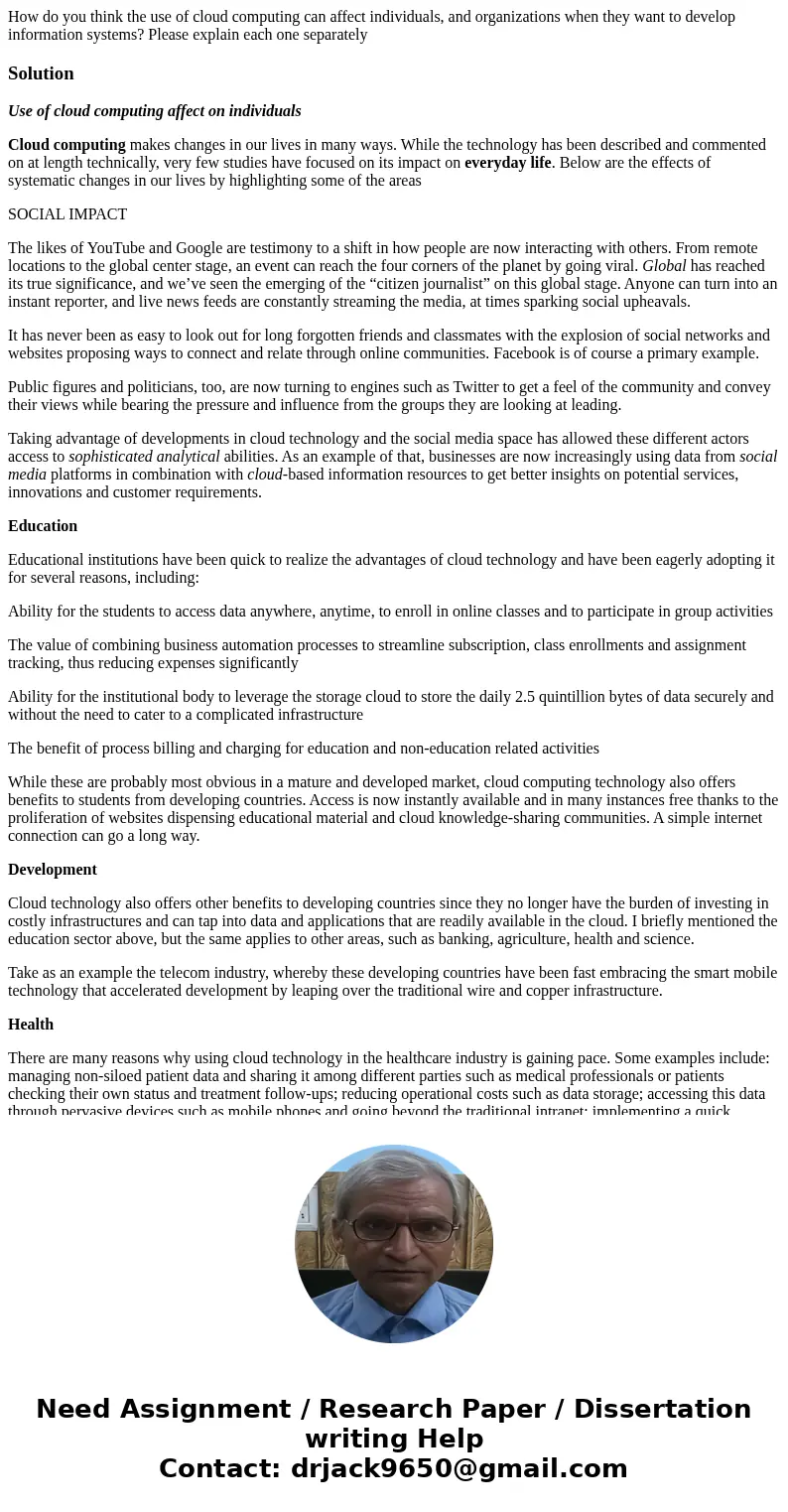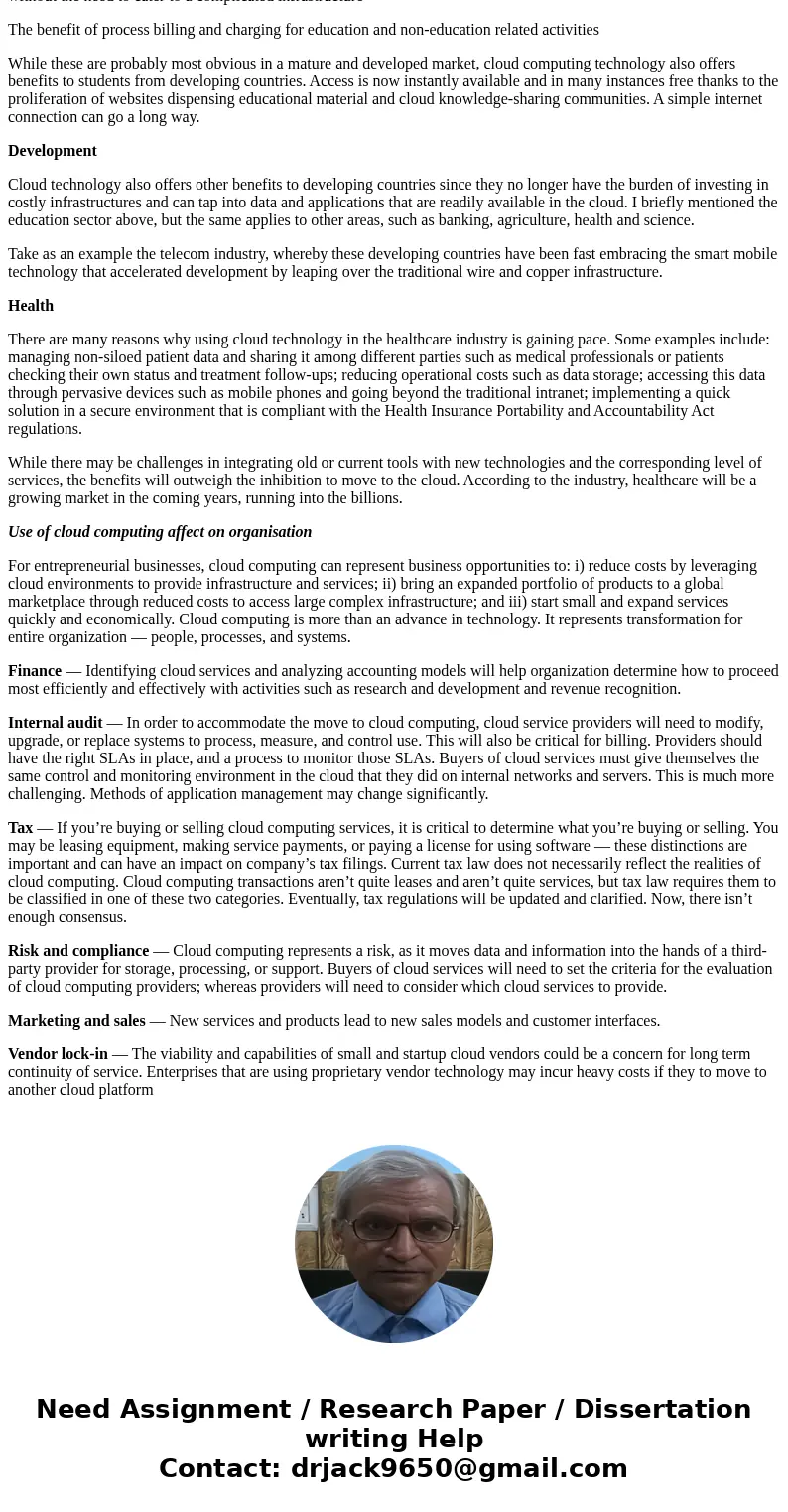How do you think the use of cloud computing can affect indiv
Solution
Use of cloud computing affect on individuals
Cloud computing makes changes in our lives in many ways. While the technology has been described and commented on at length technically, very few studies have focused on its impact on everyday life. Below are the effects of systematic changes in our lives by highlighting some of the areas
SOCIAL IMPACT
The likes of YouTube and Google are testimony to a shift in how people are now interacting with others. From remote locations to the global center stage, an event can reach the four corners of the planet by going viral. Global has reached its true significance, and we’ve seen the emerging of the “citizen journalist” on this global stage. Anyone can turn into an instant reporter, and live news feeds are constantly streaming the media, at times sparking social upheavals.
It has never been as easy to look out for long forgotten friends and classmates with the explosion of social networks and websites proposing ways to connect and relate through online communities. Facebook is of course a primary example.
Public figures and politicians, too, are now turning to engines such as Twitter to get a feel of the community and convey their views while bearing the pressure and influence from the groups they are looking at leading.
Taking advantage of developments in cloud technology and the social media space has allowed these different actors access to sophisticated analytical abilities. As an example of that, businesses are now increasingly using data from social media platforms in combination with cloud-based information resources to get better insights on potential services, innovations and customer requirements.
Education
Educational institutions have been quick to realize the advantages of cloud technology and have been eagerly adopting it for several reasons, including:
Ability for the students to access data anywhere, anytime, to enroll in online classes and to participate in group activities
The value of combining business automation processes to streamline subscription, class enrollments and assignment tracking, thus reducing expenses significantly
Ability for the institutional body to leverage the storage cloud to store the daily 2.5 quintillion bytes of data securely and without the need to cater to a complicated infrastructure
The benefit of process billing and charging for education and non-education related activities
While these are probably most obvious in a mature and developed market, cloud computing technology also offers benefits to students from developing countries. Access is now instantly available and in many instances free thanks to the proliferation of websites dispensing educational material and cloud knowledge-sharing communities. A simple internet connection can go a long way.
Development
Cloud technology also offers other benefits to developing countries since they no longer have the burden of investing in costly infrastructures and can tap into data and applications that are readily available in the cloud. I briefly mentioned the education sector above, but the same applies to other areas, such as banking, agriculture, health and science.
Take as an example the telecom industry, whereby these developing countries have been fast embracing the smart mobile technology that accelerated development by leaping over the traditional wire and copper infrastructure.
Health
There are many reasons why using cloud technology in the healthcare industry is gaining pace. Some examples include: managing non-siloed patient data and sharing it among different parties such as medical professionals or patients checking their own status and treatment follow-ups; reducing operational costs such as data storage; accessing this data through pervasive devices such as mobile phones and going beyond the traditional intranet; implementing a quick solution in a secure environment that is compliant with the Health Insurance Portability and Accountability Act regulations.
While there may be challenges in integrating old or current tools with new technologies and the corresponding level of services, the benefits will outweigh the inhibition to move to the cloud. According to the industry, healthcare will be a growing market in the coming years, running into the billions.
Use of cloud computing affect on organisation
For entrepreneurial businesses, cloud computing can represent business opportunities to: i) reduce costs by leveraging cloud environments to provide infrastructure and services; ii) bring an expanded portfolio of products to a global marketplace through reduced costs to access large complex infrastructure; and iii) start small and expand services quickly and economically. Cloud computing is more than an advance in technology. It represents transformation for entire organization — people, processes, and systems.
Finance — Identifying cloud services and analyzing accounting models will help organization determine how to proceed most efficiently and effectively with activities such as research and development and revenue recognition.
Internal audit — In order to accommodate the move to cloud computing, cloud service providers will need to modify, upgrade, or replace systems to process, measure, and control use. This will also be critical for billing. Providers should have the right SLAs in place, and a process to monitor those SLAs. Buyers of cloud services must give themselves the same control and monitoring environment in the cloud that they did on internal networks and servers. This is much more challenging. Methods of application management may change significantly.
Tax — If you’re buying or selling cloud computing services, it is critical to determine what you’re buying or selling. You may be leasing equipment, making service payments, or paying a license for using software — these distinctions are important and can have an impact on company’s tax filings. Current tax law does not necessarily reflect the realities of cloud computing. Cloud computing transactions aren’t quite leases and aren’t quite services, but tax law requires them to be classified in one of these two categories. Eventually, tax regulations will be updated and clarified. Now, there isn’t enough consensus.
Risk and compliance — Cloud computing represents a risk, as it moves data and information into the hands of a third-party provider for storage, processing, or support. Buyers of cloud services will need to set the criteria for the evaluation of cloud computing providers; whereas providers will need to consider which cloud services to provide.
Marketing and sales — New services and products lead to new sales models and customer interfaces.
Vendor lock-in — The viability and capabilities of small and startup cloud vendors could be a concern for long term continuity of service. Enterprises that are using proprietary vendor technology may incur heavy costs if they to move to another cloud platform


 Homework Sourse
Homework Sourse